Equipped with extensive online information, risk averse B2B buyers can be elusive. With competing priorities, buyers erect walls, making it difficult for sales to engage and overcome buyer inertia. As highlighted in our last blog, the biggest sales challenge early in the sales cycle is usually combatting the status quo and getting a buyer to evaluate your solution with the active involvement of your sales team.
Sales Breakthrough – the Evaluation Stage. Not all buying processes are predictable, but there is often that critical point in the sales cycle when the buyer pivots 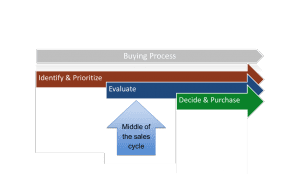 to an active evaluation phase. The sales rep believes that he or she has overcome initial obstacles, obtaining commitment from real buyers with budget to allocate time and bandwidth to Evaluate your solution. If the sales rep’s perception is correct, a deal has become more probable and deserves the investment of additional sales resources. This evaluation stage of the buying cycle is the point where free trials or paid pilots may come into play and where the sales rep draws on the expertise of other members of the sales team for group presentations and engagement with the buyer team.
to an active evaluation phase. The sales rep believes that he or she has overcome initial obstacles, obtaining commitment from real buyers with budget to allocate time and bandwidth to Evaluate your solution. If the sales rep’s perception is correct, a deal has become more probable and deserves the investment of additional sales resources. This evaluation stage of the buying cycle is the point where free trials or paid pilots may come into play and where the sales rep draws on the expertise of other members of the sales team for group presentations and engagement with the buyer team.
Understanding Sales Challenges, Richardson’s 2018 survey, identified the top 3 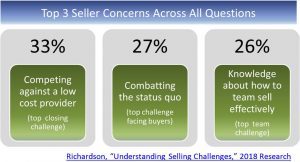 concerns among sales executives: (1) Competing against a low cost provider, (2) Combatting the status quo and (3) Knowledge about how to team sell effectively. The second problem, combatting the status quo, is usually the key sales challenge early in the sales cycle. In the middle of the sales cycle, however, the first challenge, low cost competition, and the third challenge, effective team selling, invariably become more important.
concerns among sales executives: (1) Competing against a low cost provider, (2) Combatting the status quo and (3) Knowledge about how to team sell effectively. The second problem, combatting the status quo, is usually the key sales challenge early in the sales cycle. In the middle of the sales cycle, however, the first challenge, low cost competition, and the third challenge, effective team selling, invariably become more important.
Effective Team Selling as Customers Evaluate. The time for team selling has arrived. A recent data analysis of a million recorded and transcribed sales calls by Gong, found that having multiple participants in at least one sales call increases closing rates by 258%. Sales teams are the natural response to more people participating in the B2B buying decision – 6.8 people in the average 2017 buying team. With buyers making decisions by committee, the best sales reps bring other members of their team into customer presentations. They recruit their executives, sales managers, product managers and other subject matter experts. In many organizations, they draw on designated, full time presales professionals who are part of the sales team, including solution consultants, technical sales and sales engineers.
A McKinsey team, writing in the Harvard Business Review, observed that in many B2B organizations, presales professionals represent 30-50% of commercial headcount. The McKinsey team highlighted the payoffs from augmenting presales efforts:
- five-point improvement in conversion rates,
- 6–13% improvement in revenue,
- 10–20% improvement in the speed of moving prospects through the sales process.
Inevitably, executives, subject matter experts and other presales professionals are scarce and expensive resources who are best deployed at critical points in customers’ evaluation processes. The introduction of a broader sales team in the middle of the sales cycle creates challenges, but is essential to bring the relevant expertise and influence to bear on buyer evaluations.
Middle of the Sales Cycle Objectives. Attention from a buying team during an evaluation phase is a valuable opportunity that can easily be squandered. Buyer teams are usually composed of a mix of individuals with different job descriptions, interests and attention spans. Some members of a buyer team are more enthusiastic about being in a meeting than others. Sales teams usually line up across from buying teams, knowing that they may need to herd cats.
There are four objectives of a sales team in the middle of a sales cycle as buying teams Evaluate your solution:
- Credentialize. Your sales rep is introducing new members of the team. Establish that your team knows what it is doing. Demonstrate that your team has the relevant experience. Show that your team has delivered outcomes for other, similar, customers before.
- Engage. You have a great product, but it is only as good as the customer outcomes it delivers. Make meetings customer-centric. Get customers talking about their problems and their priorities. Invite members of the buying team to trust your sales team as a key to unlocking effective discovery.
- Customize. A good sales rep has established your solution’s potential differentiation as an underpinning to the customer’s decision to Evaluate. In the middle of the sales cycle, your team needs to demonstrate that differentiation and extend it by customizing to the buyer’s needs and objectives. Customize your content. Customize your solution.
- Prove. Political and random factors may impact B2B buying, but all business buyers require some internal analysis, usually including financial impacts. Prove your solution’s differentiation. Prove that your solution will deliver. Prove that your solution is worth the money. Academically rigorous proof is seldom required. Proof or validation is always comparative vs at least one alternative. Be ready to demonstrate your solution’s value vs the status quo with its ROI. Be ready to demonstrate your solution’s value vs direct competitors with a direct TCO, cost/benefit or economic value comparison.
Value Propositions for Sales Team Conversations as Customers Evaluate. A Value Proposition can and should be the central piece of content that supports sales 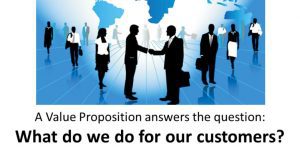 teams in achieving these objectives. At a fundamental level, a Value Proposition answers the most important question any buyer will ask: “what do you do for your customers?” A good Value Proposition is both better than, and simpler than, a complicated spreadsheet. Value Propositions should be designed with flexibility for how your sales teams have conversations. The team needs to be able to articulate your Value Proposition not just in financial terms, but also in quantitative and qualitative terms.
teams in achieving these objectives. At a fundamental level, a Value Proposition answers the most important question any buyer will ask: “what do you do for your customers?” A good Value Proposition is both better than, and simpler than, a complicated spreadsheet. Value Propositions should be designed with flexibility for how your sales teams have conversations. The team needs to be able to articulate your Value Proposition not just in financial terms, but also in quantitative and qualitative terms.
Value Propositions can readily be introduced into customer conversations as Flexible Case Studies. Good case studies are an easy and graceful way to start a discussion of what your solution does for your customer. Case studies are inherently customer-centric. Whether naming a specific customer or preserving a customer’s anonymity, they provide concrete information about what you did for another customer and the benefits your product or solution provided. Good case studies highlight how your product is better, how much better you are and what that is worth to the customer.
Buyer surveys show that the first seller to turn a vision into a clear path to value wins the business 74% of the time. SiriusDecisions’ research indicates that the number one problem for sales effectiveness is an inability for sales teams to convey their Value Proposition. For account executives and sales reps, Value Propositions in the form of Flexible Case Studies are useful early in the sales cycle in call preparation, in building sales confidence, in qualifying opportunities and in engaging customer executives.
Whether they are introduced early in the sales cycle or in the middle of the sales cycle, Flexible Case Studies allow your sales team to change assumptions as they learn more  about buyer specifics. The resulting transition of the case study to a specific Customer Value Analysis then becomes an integral part of the buyer evaluation. A Customer Value Analysis sets up the opportunity to get buy-in from customer sponsors. When a sponsor agrees to a Shared Business Case to buy with your sales team, that agreement supports faster and better results during the negotiation and procurement stages at the end of the sales cycle.
about buyer specifics. The resulting transition of the case study to a specific Customer Value Analysis then becomes an integral part of the buyer evaluation. A Customer Value Analysis sets up the opportunity to get buy-in from customer sponsors. When a sponsor agrees to a Shared Business Case to buy with your sales team, that agreement supports faster and better results during the negotiation and procurement stages at the end of the sales cycle.
How Sales Teams Use Value Propositions in the Middle of the Sales Cycle. Let’s look at how sales teams use Value Propositions to achieve each of the four objectives in a buyer evaluation.
- Credentialize. In the middle of the sales cycle, new buyer participants in the evaluation process are probably appearing. As the selling team is augmented with
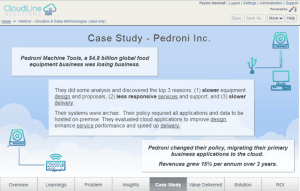 additional and relevant expertise, new sales team members are also appearing. No matter what has transpired to date in the customer conversation, new introductions are necessary.
additional and relevant expertise, new sales team members are also appearing. No matter what has transpired to date in the customer conversation, new introductions are necessary.
A Flexible Case Study, as an illustration of your Value Proposition, is an effective means of introducing your organization and new members of your sales team, especially when new presales team members have personal or in-depth knowledge of the case involved. An expert presentation of the case study points both to what your solution has delivered for another, similar customer and to how your solution and your team delivered results. This evolution in the value story from “what” to “how” invites deeper involvement by the buying team. They consider the parallels between their situation and that of another customer, imagining themselves as potential implementers of your solution. A presales presentation of results by a professional who provides an experience of “how it really works” helps to personalize the relationship between your team member and customer stakeholders evaluating whether you can deliver real business results. Presenting the Case Study or Value Analysis reveals your team’s credentials by showing:
A presales presentation of results by a professional who provides an experience of “how it really works” helps to personalize the relationship between your team member and customer stakeholders evaluating whether you can deliver real business results. Presenting the Case Study or Value Analysis reveals your team’s credentials by showing:
- Your team understands the buyer’s business and the buyer’s problems. A good
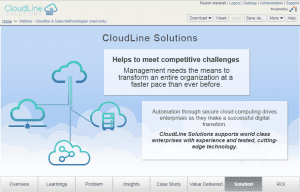 case study shows that your team understood the business and business problems of a case-study-customer well enough to provide an effective solution. Potential buyers should be confident. Your team has understood another buyer team. They can and will understand this buyer team.
case study shows that your team understood the business and business problems of a case-study-customer well enough to provide an effective solution. Potential buyers should be confident. Your team has understood another buyer team. They can and will understand this buyer team.  Your team knows how to deliver results. An effectively presented case study by a subject matter expert demonstrates that your team delivered results and illustrates how your solution delivered those results. While some of these results may be qualitative in nature, quantitative and financial results delivered to the case-study-customer strengthen the case. Making the transition from a Case Study to a specific Value Analysis for the potential buyer based on their problems and their business metrics helps buyer teams to understand that the results you have delivered to others were not a fluke and can be replicated.
Your team knows how to deliver results. An effectively presented case study by a subject matter expert demonstrates that your team delivered results and illustrates how your solution delivered those results. While some of these results may be qualitative in nature, quantitative and financial results delivered to the case-study-customer strengthen the case. Making the transition from a Case Study to a specific Value Analysis for the potential buyer based on their problems and their business metrics helps buyer teams to understand that the results you have delivered to others were not a fluke and can be replicated.
- Your team understands the buyer’s business and the buyer’s problems. A good
- Engage. Good sales professionals know instinctively that getting the customer talking is crucial. Qualified presales professionals and subject matter experts, introduced into a relationship partway through the sales cycle, may not start with the same instincts. By nature, presales professionals are smart. They know their stuff. They have gotten A’s in school for accuracy and completeness in their answers.
These presales tendencies are often reflected in customer meetings. Their product is great. They know everything about it. Their time is limited, given their busy schedule. They are used to being the smartest person in the room. So they launch into a product monologue, covering all the technical details in the brief time that they have.
Meeting results are predictable. Buyer finance and operations professionals glaze over, understanding half of what is said. Buyer technical experts hijack the meeting with the toughest questions they can think of – they are also used to being the smartest person in the room. Buyer executives tune out, check their mobile devices and find an excuse to leave the meeting.
Positioning a Value Proposition at the center of an in-depth customer presentation can be transformative. Flexible Case Studies and Value Propositions help presales presenters to rise above their natural techno-speak and product-centricity with content that empowers and drives them to be customer-centric and to focus on customer outcomes. Value Propositions help sales professionals to keep the meeting focused on the main event – how your solution delivers results. There are a number of positive consequences:
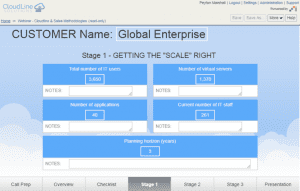 Customer-centric meeting preparation. Sales teams preparing to discuss Flexible Case Studies and customer-specific Value Analyses collaborate differently in their meeting preparation. The team focuses on their understanding of the customer’s business – the problems, needs and outcomes that matter specifically to this buyer. The team naturally considers the customer’s business situation and how your solution can deliver results that will move the needle for the buyer.
Customer-centric meeting preparation. Sales teams preparing to discuss Flexible Case Studies and customer-specific Value Analyses collaborate differently in their meeting preparation. The team focuses on their understanding of the customer’s business – the problems, needs and outcomes that matter specifically to this buyer. The team naturally considers the customer’s business situation and how your solution can deliver results that will move the needle for the buyer.
There is a risk at this stage of the sales cycle that can arise from a combination of team attitudes and the design of the Value Proposition itself. When you hear “we need to get all the data right,” you have a problem. Value Analyses, just like good case studies, do not need exact data. Sales teams can present good Value Propositions confidently as representative, based on reasonable benchmarks and based on your experience with other customers. Value Analyses can be adjusted and customized through the sales process based on customer feedback.- Customer-centric presentations. Whether in Flexible Case Study form or as a more tailored Value Analysis, a Value Proposition, by its nature, engages a broad customer audience. It centers the discussion on the customer’s business problems and the customer’s business results.
A well-designed Value Proposition invites a presenter to get customer feedback and invites a buyer audience to engage. When messaging of your differentiation is qualitative, quantitative and financial, it provides business language that can be understood by customer sponsors, technical experts, operating professionals, finance professionals and senior executives.
Different advantages or value drivers of your solution may be more or less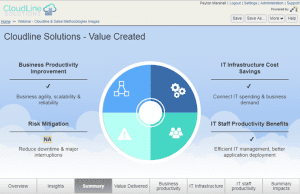 important to different customer stakeholders. When discussing a Value Analysis, a sales team can identify what matters to whom, as well as what elements of your differentiation have the greatest overall impact on the buying organization’s results. Well-designed Value Propositions prompt customer discussion and help focus sales teams on messages that resonate.
important to different customer stakeholders. When discussing a Value Analysis, a sales team can identify what matters to whom, as well as what elements of your differentiation have the greatest overall impact on the buying organization’s results. Well-designed Value Propositions prompt customer discussion and help focus sales teams on messages that resonate.
As a Flexible Case Study makes a transition to a customer-specific Value Analysis, it also invites the customer to engage in conversations about their financial and operating metrics. Not all customers are trusting or forthcoming on their performance numbers, but drawing buyer reactions based on reasonable starting points from benchmarks and broader experience is an effective means of discovery. It almost always provides earlier and better feedback than a list of 20 questions with blank answers. A few prominently displayed key assumptions invite comments and result in customers volunteering information about their business.
it also invites the customer to engage in conversations about their financial and operating metrics. Not all customers are trusting or forthcoming on their performance numbers, but drawing buyer reactions based on reasonable starting points from benchmarks and broader experience is an effective means of discovery. It almost always provides earlier and better feedback than a list of 20 questions with blank answers. A few prominently displayed key assumptions invite comments and result in customers volunteering information about their business.
If the Value Proposition is interactive this builds flexibility into the conversation. Simple well-designed messages keep stakeholders engaged. Modification and customization of assumptions becomes an initial successful transaction in the conversation, inviting the buyer to trust the sales team. The ability to drill down to get support builds trust. Transparency in responding to questions builds trust. - Manage multiple stakeholders. Any big meeting or sales pitch usually has multiple buyer stakeholders. The problem with technical questions in those meetings is technical answers. Answering a technical question with a “value delivered,” business answer keeps the non-techies, especially the executives, engaged in the meeting.
 One or two crisp answers to detailed questions about a Value Proposition in a meeting helps to build confidence in the buying team. Descending into a line-by-line analysis or a detailed back-and-forth dialog that wastes scarce buyer group time is frequently a tactical meeting blunder. Setting up an offline discussion between buyer and seller technical experts of Value Proposition assumptions is usually a better way to manage stakeholders and meeting dynamics. Those smaller group follow-ups are often a better way to bring buyer experts on board than in a large meeting with a large audience. Small group follow-ups help avoid the occasional political instincts of a buyer techie trying to look smart in public.
One or two crisp answers to detailed questions about a Value Proposition in a meeting helps to build confidence in the buying team. Descending into a line-by-line analysis or a detailed back-and-forth dialog that wastes scarce buyer group time is frequently a tactical meeting blunder. Setting up an offline discussion between buyer and seller technical experts of Value Proposition assumptions is usually a better way to manage stakeholders and meeting dynamics. Those smaller group follow-ups are often a better way to bring buyer experts on board than in a large meeting with a large audience. Small group follow-ups help avoid the occasional political instincts of a buyer techie trying to look smart in public. - Become a trusted advisor. The best sales teams are set up so that different members of the team have distinct roles and different relationships with customer stakeholders. Value Propositions highlight the overall alignment between the
 selling organization and the buyer organization. Value Proposition discussions center on how the seller will deliver buyer results. This helps to elevate the relationship from transactional in nature to a strategic partnership.The best presales teams have the objective to establish trusted advisory relationships with buyers. This is a way to differentiate your team from the competition. Any trust that buyers grant to sellers is probably more than a reward for telling the truth. It is usually a perception of your team and your organization as a strategic partner, aligned with the buyer on a common objective. A Value Proposition underlines the point that the objective common to buyer and seller is to realize customer value.
selling organization and the buyer organization. Value Proposition discussions center on how the seller will deliver buyer results. This helps to elevate the relationship from transactional in nature to a strategic partnership.The best presales teams have the objective to establish trusted advisory relationships with buyers. This is a way to differentiate your team from the competition. Any trust that buyers grant to sellers is probably more than a reward for telling the truth. It is usually a perception of your team and your organization as a strategic partner, aligned with the buyer on a common objective. A Value Proposition underlines the point that the objective common to buyer and seller is to realize customer value.
- Customize. By the middle of the sales cycle, a good sales rep has already worked hard to connect with a qualified buyer. The buyer is now beyond getting all of their purchasing information online. The buyer has assembled the right team and obtained team commitment to Evaluate your solution. Along the way, a good rep has started the battle against commoditization and against low cost alternatives by highlighting the potential differentiation of your solution. The good rep may have started or prepared the buyer for a substantive discussion of the value of that differentiation and the financial results that you can deliver.
 In the middle of the sales cycle, your team will need to demonstrate and validate that differentiation and its value. But the best sales teams with the most innovative solutions extend that differentiation by customizing their content and their solution to the buyer’s needs and objectives.
In the middle of the sales cycle, your team will need to demonstrate and validate that differentiation and its value. But the best sales teams with the most innovative solutions extend that differentiation by customizing their content and their solution to the buyer’s needs and objectives.
Customization is a means to establish an exclusive advantage in the mind of the buyer in order to: (1) reduce the likelihood that you will be put into an RFP or other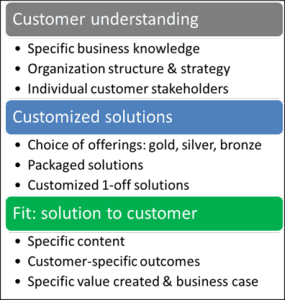 competitive bid process with multiple vendors, and (2) establish the terms of any RFP or other comparison in your favor if a competitive process is unavoidable.
competitive bid process with multiple vendors, and (2) establish the terms of any RFP or other comparison in your favor if a competitive process is unavoidable.
- Customize your content. The technology and the data are available to adapt and tailor content and conversations to specific customer information. Commercial teams with good marketing automation and good CRM disciplines capture relevant data to support account-based marketing. Sales conversations can be better informed to focus more deliberately on business problems that will resonate with key customer contacts.
Sales teams that follow up on their calls with customized information and customized feedback give buying teams a reason to stay engaged and connected. Buyers have plenty of uncustomized information available to them online. Customized follow-up materials provide selling teams with an edge. The best sales enablement, field marketing and product management teams make customization easy for sales teams. A readily adaptable Value Proposition represents a core piece of content that can be tailored to each buyer as a specific Business Case to buy. Agreeing on that customized Business Case with a buyer sponsor is an opportunity for buyer-seller collaboration. - Customize your solution. The complexity of many offerings and how they fit buyer needs often makes solution customization a key part of a sales team’s role. Solution customization is frequently a core commercial strategy to improve profitability across market segments. Tailoring product-like offerings to target different segments (e.g. gold, silver, bronze), customizing packages of components and customizing seemingly one-off solutions are all approaches that (1) help differentiate an offering in a way that fits the customer, (2) make simple price comparisons more challenging for buyers, and (3) create exclusivity in the relationship between sellers and buyers.
Experienced sales, presales and implementation professionals naturally get involved in the evaluation phase to guide buying teams through the process. A specific Customer Value Analysis can and should serve as a primary means to customize solutions to buyer needs and circumstances.
Starting that customization process based on value in the middle of the sales cycle also puts the right dynamic in place for later negotiation. The best sales teams position themselves to respond to procurement professionals or negotiators seeking price concessions with price-value tradeoffs. 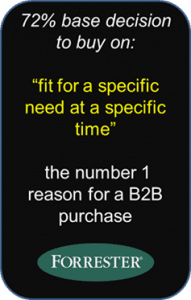 Connect solution customization to customer specifics. Making the connection between customer-specific insights and customer-specific solutions targets the number one reason for a B2B purchase – the fit of a solution to a customer. A Value Proposition supports a conversation about the best fit of your potential solutions to the specific needs of that account. It highlights specific customer outcomes and builds a common business case that becomes part of the strategic business partnership between sales teams and buying teams.
Connect solution customization to customer specifics. Making the connection between customer-specific insights and customer-specific solutions targets the number one reason for a B2B purchase – the fit of a solution to a customer. A Value Proposition supports a conversation about the best fit of your potential solutions to the specific needs of that account. It highlights specific customer outcomes and builds a common business case that becomes part of the strategic business partnership between sales teams and buying teams.
- Customize your content. The technology and the data are available to adapt and tailor content and conversations to specific customer information. Commercial teams with good marketing automation and good CRM disciplines capture relevant data to support account-based marketing. Sales conversations can be better informed to focus more deliberately on business problems that will resonate with key customer contacts.
- Prove. Political and random factors may influence B2B buying, but virtually all business buyers require some internal, rational analysis, often including a financial
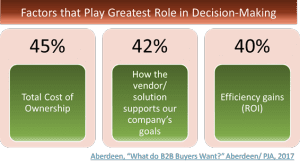 evaluation. An Aberdeen PJA survey asked buyers to select the two factors that play the greatest role in their decision to purchase a product or solution. The top 3 buyer answers, in order, were:
evaluation. An Aberdeen PJA survey asked buyers to select the two factors that play the greatest role in their decision to purchase a product or solution. The top 3 buyer answers, in order, were:
- Total Cost of Ownership.
- How the vendor’s solution supports the customer’s goals.
- ROI and efficiency gains.
At a rational level, addressing any or all of these factors takes some sort of persuasive evidence or proof points. The term “proof” is a loaded one, as academically rigorous proof is seldom required. The proof standards for a Value Proposition are almost never those of a mathematical proof or an FDA drug approval. When commercial teams set too high a standard of proof for Value Proposition content, they lose sight of the practical needs of potential buyers. The goal is to get the customer to buy at a reasonable price. The substantive part of a value conversation will be successful if it (i) is persuasive that your solution delivers business results, (ii) satisfies the buyer’s challenges, (iii) refines specific assumptions the buyer sees as relevant and (iii) earns the buyer’s trust in your team’s understanding of them and their business.
Proof or validation is always comparative versus at least one alternative. The best Value Propositions provide flexibility for sales teams to provide customers with comparisons of your solution to: (a) the status quo (“why change?” and “why change now?”) and (b) direct competitors (“why change to your solution?” and “why buy your solution at a premium price?”). A good bottom-line comparison vs the status quo can often be summarized with ROI, payback and Net Value delivered. A good comparison vs direct competitors can often be made using a comparative graph of TCO, cost/benefit or economic value.
- Your solution is differentiated. Good product marketing usually starts with messaging and visuals that go beyond product features to demonstrate differentiation in the benefits that your solution delivers to a rational buyer.
 Clear and powerful qualitative messages are a good place to start. Qualitative anecdotes about another customer, delivered by a sales or presales professional
Clear and powerful qualitative messages are a good place to start. Qualitative anecdotes about another customer, delivered by a sales or presales professional  with the right credentials, make these messages more persuasive. Visuals, videos and testimonials all build up both the rational and the emotional evidence that make quantitative claims plausible about how much better you are.
with the right credentials, make these messages more persuasive. Visuals, videos and testimonials all build up both the rational and the emotional evidence that make quantitative claims plausible about how much better you are.
Those qualitative messages and images also focus on the customer’s business. They set up a good customer conversation about business problems and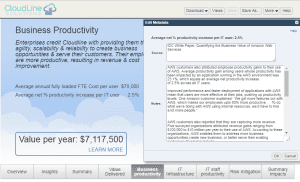 priorities. Quantitative conversations about the customer’s business, even if they have no rigorous logical connection with any direct quantitative claims about your solution’s benefits, help to make important emotional connections, building trust and lowering the burden of proof for your solution’s claims.
priorities. Quantitative conversations about the customer’s business, even if they have no rigorous logical connection with any direct quantitative claims about your solution’s benefits, help to make important emotional connections, building trust and lowering the burden of proof for your solution’s claims.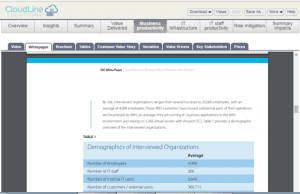 Whenever you have quantitative evidence based on development studies, outcome studies, case studies or surveys, you have a stronger basis for persuasive proof. At a minimum, provide sales teams with supporting documents and collateral highlighting and bolstering the quantitative evidance.
Whenever you have quantitative evidence based on development studies, outcome studies, case studies or surveys, you have a stronger basis for persuasive proof. At a minimum, provide sales teams with supporting documents and collateral highlighting and bolstering the quantitative evidance.
In addition to supporting evidence, consider the means for your team to test customer sensitivity to assumptions about what your solution provides. If your buyers find it plausible that your solution is differentiated and delivers valuable results, even based on conservative assumptions, this is often as important as the believability or applicability of the best outcome study results.
The fundamental aim is not to have the most rigorously defensible claims or to win a debate tournament based on line-by-line scoring of argumentation in a flowchart. It is to connect with human, risk-averse buyers, to motivate them to change and to help them find a reasonable basis for a decision to buy your solution. These decisions are often as much about assessing the team they are buying from as they are about whether that team’s content has successfully exceeded high absolute standards of proof. Providing just as much information as they need to make these decisions is usually better than providing TMI. - Your solution will deliver to the buyer. Proof in this case is a buyer vision of, or belief in, a plausible, positive outcome, based on supporting evidence that may be
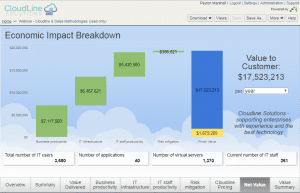 some combination of qualitative, quantitative and financial. It is great if this result is a clear and compelling financial result, a high ROI or a big increase in annual profitability. But the key is that the buying team believes, on balance, in moving forward with your solution because it accomplishes their business objectives.
some combination of qualitative, quantitative and financial. It is great if this result is a clear and compelling financial result, a high ROI or a big increase in annual profitability. But the key is that the buying team believes, on balance, in moving forward with your solution because it accomplishes their business objectives. - Your solution is worth the money. The best sales teams sell value as a precursor to any price discussions. The best sales teams focus on delivering results to the buyer. If your sales team establishes the value of your solution’s differentiation persuasively in the eyes of the buyer team, that will provide a solid emotional and
 analytical foundation for the conversation about whether it is worth the money. The final step is about assembling the believable supporting information and math to move the buying process through the later stages of the buyer’s organizational process.
analytical foundation for the conversation about whether it is worth the money. The final step is about assembling the believable supporting information and math to move the buying process through the later stages of the buyer’s organizational process.
Value Propositions as Tools. The best B2B enterprises deploy Value Propositions to improve B2B sales performance, addressing sales challenges in a way consistent with an organization’s sales training, throughout the B2B sales cycle. They are useful early in the sales cycle as Flexible Case Studies for sales to qualify opportunities and engage customer executives. In the middle of the sales cycle, Value Propositions provide Customer Value Analyses as an important consultative selling tool that address presales challenges. As customers decide to purchase, the Value Proposition becomes a Shared Business Case, collaboratively agreed between sales executives and customer sponsors, that speed the closing process as a buyer’s financial rationale to buy.
It isn’t hard to start value selling. Value Propositions provide core sales content that helps sales teams communicate what your solution does for your customers. Value Propositions are a shared basis for collaboration that help sales teams win.
For more information on sales use of Value Propositions see Using Propositions as an Effective Sales Tool

